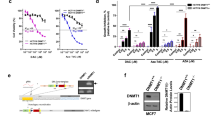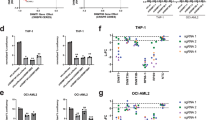Abstract
The deoxycytidine analog 5-aza-2′-deoxycitidine (5-aza-dC) is a potent chemotherapeutic agent effective against selective types of cancer. The molecular mechanism by which 5-aza-dC induces cancer cell death, however, is not fully understood. It has been accepted that the mechanism of toxicity is due to the covalent binding between the DNA methyltransferase (Dnmt) and 5-aza-dC-substituted DNA. In order to define which member of the Dnmt family plays a dominant role in the cytotoxicity, we examined the effect of 5-aza-dC on cell growth and apoptosis in various Dnmt null mutant embryonic stem (ES) cells. Of interest, Dnmt3a–Dnmt3b double null ES cells were highly resistant to 5-aza-dC when compared to wild type, Dnmt3a null, Dnmt3b null, or Dnmt1 null ES cells. The cellular sensitivity to 5-aza-dC correlated well with the expression status of Dnmt3 in both undifferentiated and differentiated ES cells. When exogenous Dnmt3a or Dnmt3b was expressed in double null ES cells, the sensitivity to 5-aza-dC was partially restored. These results suggest that the cytotoxic effect of 5-aza-dC may be mediated primarily through Dnmt3a and Dnmt3b de novo DNA methyltransferases. Further, the ability to form Dnmt-DNA adducts was similar in Dnmt1 and Dnmt3, and the expression level of Dnmt3 was not higher than that of Dnmt1 in ES cells. Therefore, Dnmt3-DNA adducts may be more effective for inducing apoptosis than Dnmt1-DNA adducts. These results imply a therapeutic potential of 5-aza-dC to cancers expressing Dnmt3.
This is a preview of subscription content, access via your institution
Access options
Subscribe to this journal
Receive 50 print issues and online access
$259.00 per year
only $5.18 per issue
Buy this article
- Purchase on Springer Link
- Instant access to full article PDF
Prices may be subject to local taxes which are calculated during checkout






Similar content being viewed by others
References
Bachman KE, Rountree MR and Baylin SB . (2001). J. Biol. Chem., 276, 32282–32287.
Baylin SB, Herman JG, Graff JR, Vertino PM and Issa JP . (1998). Adv. Cancer Res., 72, 141–196.
Beaulieu N, Morin S, Chute IC, Robert MF, Nguyen H and MacLeod AR . (2002). J. Biol. Chem., 277, 28176–28181.
Belinsky SA, Nikula KJ, Baylin SB and Issa JP . (1996). Proc. Natl. Acad. Sci. USA, 93, 4045–4050.
Bestor TH . (2000). Hum. Mol. Genet., 9, 2395–2402.
Chen T, Ueda Y, Dodge JE, Wang Z and Li E . (2003). Mol. Cell. Biol., 23, 5594–5605.
Chen T, Ueda Y, Xie S and Li E . (2002). J. Biol. Chem., 277, 38746–38754.
Christman JK . (2002). Oncogene, 21, 5483–5495.
Chuang LS, Ian HI, Koh TW, Ng HH, Xu G and Li BF . (1997). Science, 277, 1996–2000.
Costello JF and Plass C . (2001). J. Med. Genet., 38, 285–303.
Eden A, Gaudet F, Waghmare A and Jaenisch R . (2003). Science, 300, 455.
el-Deiry WS, Nelkin BD, Celano P, Yen RW, Falco JP, Hamilton SR and Baylin SB . (1991). Proc. Natl. Acad. Sci. USA, 88, 3470–3474.
Ferguson AT, Vertino PM, Spitzner JR, Baylin SB, Muller MT and Davidson NE . (1997). J. Biol. Chem., 272, 32260–32266.
Gabbara S and Bhagwat AS . (1995). Biochem. J., 307 (Part 1), 87–92.
Gaudet F, Hodgson JG, Eden A, Jackson-Grusby L, Dausman J, Gray JW, Leonhardt H and Jaenisch R . (2003). Science, 300, 489–492.
Girault I, Tozlu S, Lidereau R and Bieche I . (2003). Clin. Cancer Res., 9, 4415–4422.
Goffin J and Eisenhauer E . (2002). Ann. Oncol., 13, 1699–1716.
Gorczyca W, Gong J, Ardelt B, Traganos F and Darzynkiewicz Z . (1993). Cancer Res., 53, 3186–3192.
Hamaguchi I, Woods NB, Panagopoulos I, Andersson E, Mikkola H, Fahlman C, Zufferey R, Carlsson L, Trono D and Karlsson S . (2000). J. Virol., 74, 10778–10784.
Issa JP, Vertino PM, Wu J, Sazawal S, Celano P, Nelkin BD, Hamilton SR and Baylin SB . (1993). J. Natl. Cancer Inst., 85, 1235–1240.
Iwakuma T, Cui Y and Chang LJ . (1999). Virology, 261, 120–132.
Jones PA and Laird PW . (1999). Nat. Genet., 21, 163–167.
Jones PA and Taylor SM . (1980). Cell, 20, 85–93.
Juttermann R, Li E and Jaenisch R . (1994). Proc. Natl. Acad. Sci. USA, 91, 11797–11801.
Kanai Y, Ushijima S, Kondo Y, Nakanishi Y and Hirohashi S . (2001). Int. J. Cancer, 91, 205–212.
Karpf AR, Moore BC, Ririe TO and Jones DA . (2001). Mol. Pharmacol., 59, 751–757.
Kizaki H, Ohnishi Y, Azuma Y, Mizuno Y and Ohsaka F . (1993). Immunopharmacology, 25, 19–27.
Laird PW and Jaenisch R . (1996). Annu. Rev. Genet., 30, 441–464.
Leonhardt H, Page AW, Weier HU and Bestor TH . (1992). Cell, 71, 865–873.
Lin T, Chao C, Saito S, Mazur SJ, Murphy ME, Appella E and Xu Y . (2005). Nat. Cell Biol., 7, 165–171.
Liu K, Wang YF, Cantemir C and Muller MT . (2003). Mol. Cell. Biol., 23, 2709–2719.
Melki JR, Warnecke P, Vincent PC and Clark SJ . (1998). Leukemia, 12, 311–316.
Michalowsky LA and Jones PA . (1987). Mol. Cell. Biol., 7, 3076–3083.
Mizuno S, Chijiwa T, Okamura T, Akashi K, Fukumaki Y, Niho Y and Sasaki H . (2001). Blood, 97, 1172–1179.
Murakami T, Li X, Gong J, Bhatia U, Traganos F and Darzynkiewicz Z . (1995). Cancer Res., 55, 3093–3098.
Nieto M, Samper E, Fraga MF, Gonzalez de Buitrago G, Esteller M and Serrano M . (2004). Oncogene, 23, 735–743.
Okano M, Bell DW, Haber DA and Li E . (1999). Cell, 99, 247–257.
Okano M, Xie S and Li E . (1998). Nat. Genet., 19, 219–220.
Pfeifer A, Ikawa M, Dayn Y and Verma IM . (2002). Proc. Natl. Acad. Sci. USA, 99, 2140–2145.
Pradhan S, Bacolla A, Wells RD and Roberts RJ . (1999). J. Biol. Chem., 274, 33002–33010.
Robertson KD, Uzvolgyi E, Liang G, Talmadge C, Sumegi J, Gonzales FA and Jones PA . (1999). Nucleic Acids Res., 27, 2291–2298.
Sabapathy K, Klemm M, Jaenisch R and Wagner EF . (1997). EMBO J., 16, 6217–6229.
Saito Y, Kanai Y, Sakamoto M, Saito H, Ishii H and Hirohashi S . (2001). Hepatology, 33, 561–568.
Santi DV, Norment A and Garrett CE . (1984). Proc. Natl. Acad. Sci. USA, 81, 6993–6997.
Santini V, Kantarjian HM and Issa JP . (2001). Ann. Intern. Med., 134, 573–586.
Schneider-Stock R, Diab-Asseff M, Rohrbeck A, Foltzer-Jourdainne C, Boltze C, Hartig R, Schonfeld P, Roessner A and Gali-Muhtasib H . (2005). J. Pharmacol. Exp. Ther., 312, 525–536.
Shivji KK, Kenny MK and Wood RD . (1992). Cell, 69, 367–374.
Soejima K, Fang W and Rollins BJ . (2003). Oncogene, 22, 4723–4733.
Suetake L, Shi L, Watanabe D, Nakamura M and Tajima S . (2001). Cell Struct. Funct., 26, 79–86.
Takagi H, Tajima S and Asano A . (1995). Eur. J. Biochem., 231, 282–291.
Trinh BN, Long TI, Nickel AE, Shibata D and Laird PW . (2002). Mol. Cell. Biol., 22, 2906–2917.
Umar A, Buermeyer AB, Simon JA, Thomas DC, Clark AB, Liskay RM and Kunkel TA . (1996). Cell, 87, 65–73.
Weisenberger DJ, Velicescu M, Cheng JC, Gonzales FA, Liang G and Jones PA . (2004). Mol. Cancer Res., 2, 62–72.
Xie S, Wang Z, Okano M, Nogami M, Li Y, He WW, Okumura K and Li E . (1999). Gene, 236, 87–95.
Zaiss AK, Son S and Chang LJ . (2002). J. Virol., 76, 7209–7219.
Zhu WG, Hileman T, Ke Y, Wang P, Lu S, Duan W, Dai Z, Tong T, Villalona-Calero MA, Plass C and Otterson GA . (2004). J. Biol. Chem., 279, 15161–15166.
Acknowledgements
We thank Dr En Li for providing Dnmt null ES cells, Dr Shoji Tajima for anti-Dnmt1 antibody, and Dr Keith D Robertson and Dr Thomas C Rowe for critical reading of the manuscript.
Author information
Authors and Affiliations
Corresponding author
Rights and permissions
About this article
Cite this article
Oka, M., Meacham, A., Hamazaki, T. et al. De novo DNA methyltransferases Dnmt3a and Dnmt3b primarily mediate the cytotoxic effect of 5-aza-2′-deoxycytidine. Oncogene 24, 3091–3099 (2005). https://doi.org/10.1038/sj.onc.1208540
Received:
Revised:
Accepted:
Published:
Issue Date:
DOI: https://doi.org/10.1038/sj.onc.1208540
Keywords
This article is cited by
-
Association between polymorphisms and hypermethylation of CD36 gene in obese and obese diabetic Senegalese females
Diabetology & Metabolic Syndrome (2022)
-
Impact of the interaction between the polymorphisms and hypermethylation of the CD36 gene on a new biomarker of type 2 diabetes mellitus: circulating soluble CD36 (sCD36) in Senegalese females
BMC Medical Genomics (2022)
-
Global changes in epigenomes during mouse spermatogenesis: possible relation to germ cell apoptosis
Histochemistry and Cell Biology (2020)
-
MiR-142-3p is downregulated in aggressive p53 mutant mouse models of pancreatic ductal adenocarcinoma by hypermethylation of its locus
Cell Death & Disease (2018)
-
Epigenetic silencing of ZNF132 mediated by methylation-sensitive Sp1 binding promotes cancer progression in esophageal squamous cell carcinoma
Cell Death & Disease (2018)



